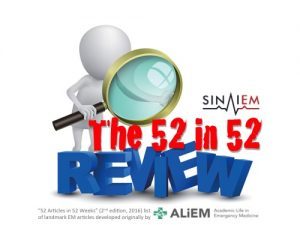Note: Some of the junior residents are unaware of what the 52 in 52 Review is. In brief. The ALIEM blog picked a list of 52 influential papers in EM (we are on version 2 now) to provide a weekly reading topic. The full list is available here.
Article Citation: Hasbun R, Abrahams J, Jekel J, Quagliarello VJ. Computed tomography of the head before lumbar puncture in adults with suspected meningitis. N Engl J Med. 2001 Dec 13;345(24):1727-33. PMID: 11742046
What we already know: Many of us have been taught to perform a CT prior to an LP to reduce the risk of LP-induced herniation. Now certainly this is not the only reason that we perform a CT before an LP. In many cases, meningitis is one among our differential, and may only reach the top of our DDx if the CT head is negative for other pathology. However, even when we have a high suspicion for meningitis we often obtain a CT first to look for evidence of elevated ICP or mass effect. Is this practice necessary?
Why this study is important: This study attempted to identify the relationship between clinical features on presentation and likelihood of findings on CT that would alter our pursuit of LP.
Brief overview of the study: From 1995-1999, adults strongly suspected of having meningitis were prospectively enrolled at Yale-New Haven prior to CT or LP. All included participants had an evaluation including the 11-scale NIH stroke scale and all had an LP. CT performance was up to provider choice. 235 patients received a CT. 66 did not. No patients herniated from CT in either group. 25% of the CTs were abnormal but only 5% showed any evidence of mass effect. Factors associated (with statistical significance) with an RR ~2 or greater of any abnormal CT finding (not only mass effect) included age > 60, recent seizure, immunocompromise, prior CNS disease and any NIH stroke scale finding. Applying these rules to the “low-risk” patients who received CT, 93/96 had completely normal CTs and none had mass effect. Interestingly, the patients who received a CT spent 2 hours longer in the ED and took ~1hr longer to receive empiric antibiotics.
Limitations: My largest concern is that the authors do not report on the percentage of each group (with and w/o “high risk” features) who ultimately had meningitis. If the low risk group is also less likely to have meningitis the results are less helpful because rather than trying to avoid CT before LP we should be finding a way to exclude them from the meningitis pathway. Second, this study took place while the AIDS epidemic remained in full swing and a healthy percentage of patients presented with well progressed opportunistic infections (including one who died of toxo herniation prior to CT). This may not be representative of a typical patient population. Third, we do not know whether there would have been findings on those who did not receive a head CT due to the observational nature of the study. In short, this study suggests that a patient who is an adult under 60, not immunocompromised and with a negative NIH stroke score in whom you have high suspicion for meningitis may not need a CT because their risk of intracranial mass effect is low. However, since so few of our high-suspicion meningitis cases meet those criteria, it is unclear how much CT use this could truly result in. Better, randomized studies are needed.

